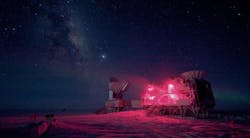A more sophisticated video explains the measurement in a nearly hour-long lecture from professor Carolin Crawford from Gresham University (London, England):
The University of California, Davis is active in Universe measurement theory. Back in 2010, they described how dark matter and gravitational lensing could be used to measure the age of the Universe. Essentially, a gravitational lens created by a galaxy surrounded by dark matter, as an example, exerts its gravitational pull on light and objects behind the lens are distorted. The researchers say, "It works something like this. Two photons of light leave the background galaxy at the same time and travel around the lens, their paths distorted in different ways by the gravitational field so that they arrive on Earth at slightly different times. Based on that time delay, it is possible to calculate the distance of the entire route, and then infer the Hubble constant."
If you can measure it, is it true? Maybe. But what about the time period before the Big Bang--isn't our Universe in theory much older and the Big Bang is just one event on an endless time horizon? I personally favor the Multiverse theory of the Universe (see http://en.wikipedia.org/wiki/Multiverse). And now, as other editorial deadlines await, I'll have to wait for the next Sunday episode of "Cosmos" (http://www.cosmosontv.com/) to get my cosmological theorizing fix for the week.


